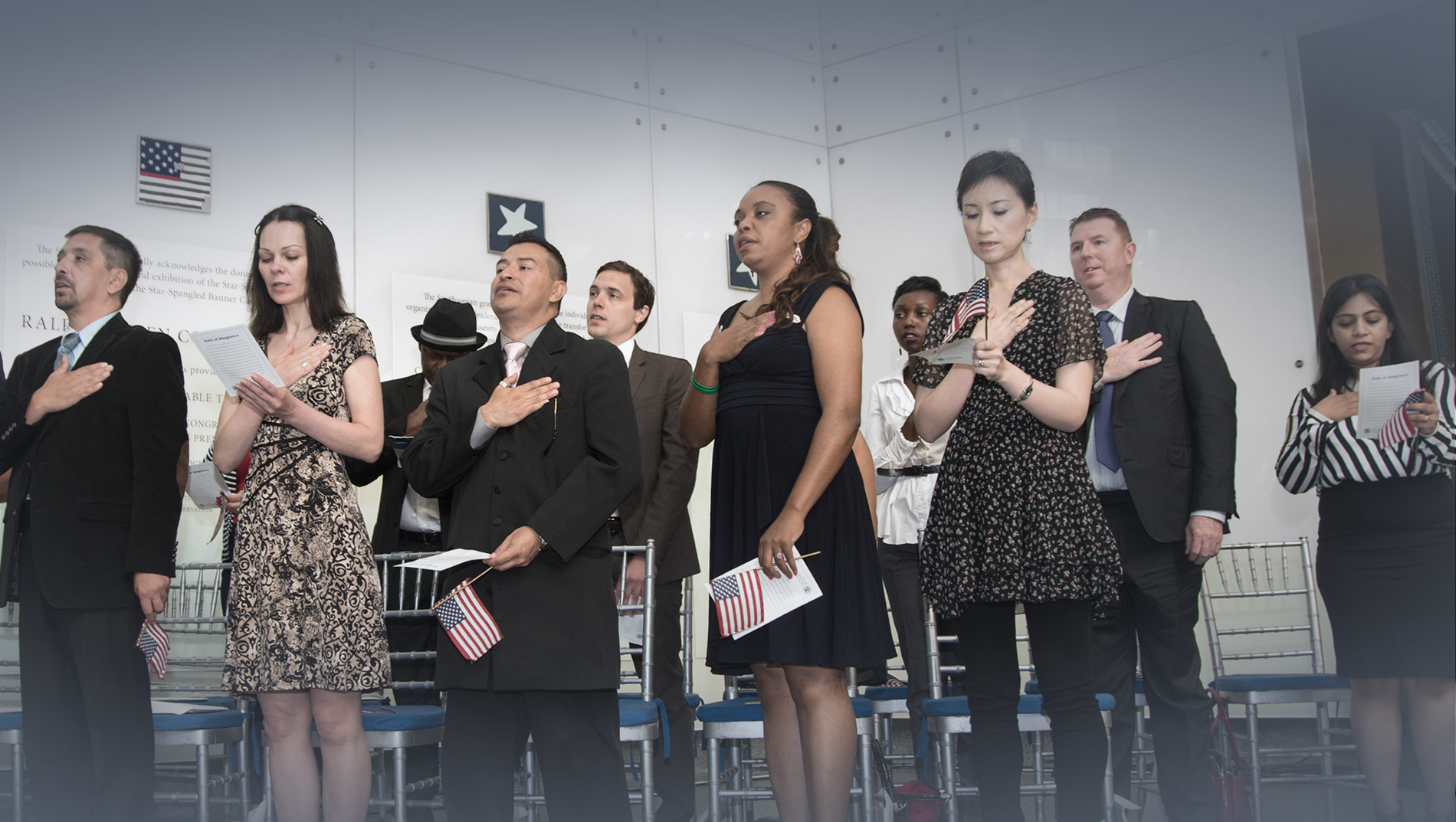Immigration 101
How the United States Immigration System Works
- How the Immigration System Works
- June 24, 2024
U.S. immigration law is very complex, and there is much confusion as to how it works. This fact sheet provides basic information…
Read More
Birthright Citizenship in the United States
- Birthright Citizenship
- October 16, 2024
This fact sheet explains birthright citizenship, the Fourteenth Amendment, and its interpretations. Who is…
Read More
Asylum in the United States
- Asylum
- August 27, 2014
Asylum seekers must navigate a difficult and complex process that can involve multiple government…
Read More
Using the Systematic Alien Verification for Entitlements (SAVE) Program for Voter Eligibility Verification
The evidence of non-citizens voting is sparse and appears subject to much exaggeration. Despite this, many states are asking the federal government for access to immigration data in order to determine whether non-citizens are on the voter registration rolls. For instance, in July 2012, the Director of U.S. Citizenship and Immigration Services (USCIS)—a division of the Department of Homeland Security (DHS)—advised the Florida Secretary of State that states, under limited circumstances, may use the Systematic Alien Verification for Entitlements (SAVE) program for verification of the citizenship status of registered voters. This issue, however, goes beyond Florida. Other states have expressed an interest in using SAVE in a similar fashion. This new development has heightened misconceptions about the SAVE program and its purpose. The Immigration Policy Center’s previously issued fact sheet about the SAVE program focuses on whether SAVE can actually verify whether an individual is in the country lawfully or not. This fact sheet focuses on whether the SAVE program can be used to accurately verify voter eligibility. It explains why SAVE is not a database of all non-citizens, why using SAVE to verify the status of individuals who have registered to vote is a misuse of the program, and how using SAVE for this purpose could lead to denying U.S. citizens the right to vote. What is the SAVE program? Read More

Chicken Little in the Voting Booth: The Non-Existent Problem of Non-Citizen Voter Fraud
A wave of restrictive voting laws is sweeping the nation. The Brennan Center for Justice at New York University School of Law counts “at least 180 restrictive bills introduced since the beginning of 2011 in 41 states.” Bills requiring voters “to show photo identification in order to vote” were signed into law in Alabama, Kansas, Rhode Island, South Carolina, Tennessee, Texas, Wisconsin, and Pennsylvania. Adding insult to injury, Alabama, Kansas, and Tennessee went a step further and required voters to present proof of U.S. citizenship in order to vote. In addition, Florida, Colorado, and New Mexico embarked upon ultimately fruitless “purges” of their voter rolls for the ostensible purpose of sweeping away anyone who might be a non-U.S. citizen. All of these actions have been undertaken in the name of preventing voter fraud, particularly illegal voting by non-citizens. Proponents of harsh voter laws often assert, without a shred of hard evidence, that hordes of immigrants are swaying election results by wheedling their way into the voting booth. However, repeated investigations over the years have found no indication that systematic vote fraud by non-citizens is anything other than the product of overactive imaginations. Fighting Phantoms: No Evidence of Widespread or Systematic Vote Fraud by Non-Citizens Read More

African Immigrants in America: A Demographic Overview
Immigrants from Africa constitute a highly diverse and rapidly growing group in the United States. As Census data demonstrate, the African foreign-born population doubled in size between 2000 and 2010. Nearly half of African immigrants are naturalized U.S. citizens, and seven-in-ten speak only English or speak it “very well.” Just under three-quarters of African immigrants are black, while roughly one-fifth are white. The largest numbers of African immigrants are found in California, New York, Texas, Maryland, and Virginia. The top countries of origin for African immigrants are Nigeria, Ethiopia, Egypt, Ghana, and Kenya. Two-fifths of African immigrants have at least a bachelor’s degree, and more than one-third work in professional jobs. Read More

Public Education for Immigrant Students: Understanding Plyler v. Doe
This fact sheet provides an overview of the Supreme Court’s decision in Plyler v. Doe and subsequent efforts by states and localities to avoid compliance with the decision. Read More

Latinos in America: A Demographic Overview
Latinos in the United States are a diverse and fast-growing group that is amassing considerable economic and political power. As data from the 2010 Census and other sources demonstrate, Latinos now account for one-sixth of the U.S. population. Most Latinos were born in this country, but over one-third are immigrants. Latinos as a whole (both foreign-born and native-born) are sizeable shares of the population and electorate in New Mexico, California, and Texas, but the fastest growing Latino populations are in South Carolina, Alabama, and Tennessee. The Mexican population is by far the largest in size, but the number of Spaniards is increasing the fastest. Latinos work in a diverse range of occupations, and nearly half of Latino households are owner occupied. Latinos also wield significant economic clout. Latino businesses and consumers sustain millions of jobs and add hundreds of billions of dollars in value to the U.S. economy. Read More

Asians in America: A Demographic Overview
Asians in the United States are a highly diverse group that is growing fast not only in size, but in political and economic power as well. Read More

The Future of a Generation: How New Americans Will Help Support Retiring Baby Boomers
The United States is in the midst of a profound demographic transformation that will long outlast the current economic downturn. In 2011, the first of the baby boomers—Americans born between 1946 and 1964—turned 65 years old. There are 77 million baby boomers, comprising nearly one quarter of the total population, and their eventual retirement will have an enormous impact on the U.S. economy. This daunting fact is central to the January 2012 employment and labor force projections from the Bureau of Labor Statistics (BLS). As the BLS projects, the retirement of the baby boomers will slow labor force growth significantly over the coming decade. Yet, at the same time, demand will grow for new workers to take the place of those who retire from the labor force, as well as for both highly skilled and less-skilled healthcare workers to look after the growing ranks of elderly Americans. In addition, the Social Security and Medicare programs will be called upon to serve a rapidly growing number of older Americans, which will leave American taxpayers hard pressed to fund those programs with their tax dollars. Read More

Opportunity and Exclusion: A Brief History of U.S. Immigration Policy
The United States and the colonial society that preceded it were created by successive waves of immigration from all corners of the globe. But public and political attitudes towards immigrants have always been ambivalent and contradictory, and sometimes hostile. The early immigrants to colonial America—from England, France, Germany, and other countries in northwestern Europe—came in search of economic opportunity and political freedom, yet they often relied upon the labor of African slaves working land taken from Native Americans. The descendants of these first European immigrants were sometimes viewed as “racially” and religiously suspect the European immigrants who came to the United States in the late 1800s from Italy, Poland, Russia, and elsewhere in southeastern Europe. The descendants of these immigrants, in turn, have often taken a dim view of the growing numbers of Latin American, Asian, and African immigrants who began to arrive in the second half of the 20th century. Read More

Eliminating Birthright Citizenship Would Not Solve the Problem of Unauthorized Immigration
There is no evidence that undocumented immigrants come to the U.S. just to give birth. Read More

Mexican Migration Patterns Signal a New Immigration Reality
Fewer Mexicans are Entering the U.S., Fewer Are Leaving, and Mexican American Births Now Outpace Immigration from Mexico Much of what we thought we knew about immigration is changing, and the new reality means we need to think differently about how we approach immigrants and immigration reform in the United States. Unauthorized immigration has clearly paused, and three-fifths of unauthorized immigrants have been in the United States for more than a decade. Immigrants are becoming more integrated into U.S. communities. Given these trends, now is the time to seriously consider comprehensive immigration reform. Read More
Make a contribution
Make a direct impact on the lives of immigrants.

